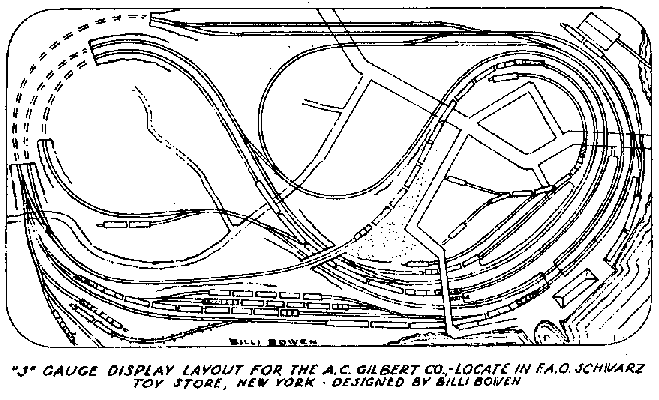
The following quote is from
a “Trend Books Model Railroading” published in 1956 by Kalmbach Publishing.
It describes the layout provided by A.C.Gilbert to FAO Schwarz.
Tin-plate can be made interesting and realistic as Billi
Bowen proved with the demonstration layout he designed for the A. C. Gilbert
Co. and which was set up in Tin-plate realistic as the F. A. O. Schwarz
Toy Store in New York City (see diagram).
It might properly be called "Hi-Rail," as no stock short-radius curves
are used, and the switches were modified to get closer track spacing. The
layout was designed to show as many trains in motion as possible, in as
realistic a setting as could be achieved, eliminating many of the undesirable
features of the usual toy store tin-plate layout.
The scenery was simple; no grandiose painted canyons with
big (and out-of-scale) bridges connecting nothing to nowhere; just ordinary
rolling country, high enough in the back corner to provide tunnels to break
the round-and-round, and on the opposite corner a touch of waterfront to
create interesting color and show the reflections of passing trains.
Enough streets and buildings were used to give the illusion of a town for
the railroad to serve. The toads, fences, etc., ran off the edge of the
platform (rather than maintaining the usual deadly parallelism) in order
to suggest the continuation of the landscape. There was quite a bit of
track, more than would be needed by an individual railroader: loops were
kept separate from each other to allow several trains to operate independently.
Now for the details of the track plan itself: the outer loop
was a single track line with two passing sidings, one in the freight yard
and the other at the opposite side of the platform. These were intended
to be automatic so that two trains could be run in opposite directions,
passing each other at each siding. The nest loop toward the center was
a single loop folded on itself so that in the center it was a double track
(it might be called a "distorted dumbbell"): this was to be equipped with
an automatic block so two trains could follow each other counterclockwise.
The last loop was a figure eight, crossing over itself, and meant mainly
for single train operation. Thus, adding the three separate routes together,
five trains could be in operation at the same time, making automatic station
stops, and obeying the signals, etc. In addition, the little four-track
freight, or rather team-yard, opposite the main passenger station was laid
out with a lead long enough to permit an operator to do a lot of switching
there and still keep clear of the main line loops. This meant the possibility
of six trains in motion.
There are several other items in the Bowen layout which don't
often find their way into tin-plate layouts (and are rather difficult to
do with the limitations of stock curves and switches); in addition to the
elimination of parallelism already mentioned, reasonable appearing tunnels
with the tracks close enough together to look as if they were not mad at
each other: several small spurs directly on the main line); freight yards
and engine terminals of adequate size, and yet compact: and the general
feeling of integration of closely spaced tracks.
As the layout actually built the area which hid the
return loops in the upper left hand corner of the sketch was larger than
shown, and was in the form of a plateau. This allowed the placing
of a small loop of HO-gauge on the top. Dressed up with trees and
a few houses, this smaller train gave the illusion of being far away from
the larger trains on the level below, and in this way, avoided the usual
mistake of having trains of different sizes running side by side.
(end of quote)
Return to S-Trains Navigation Page